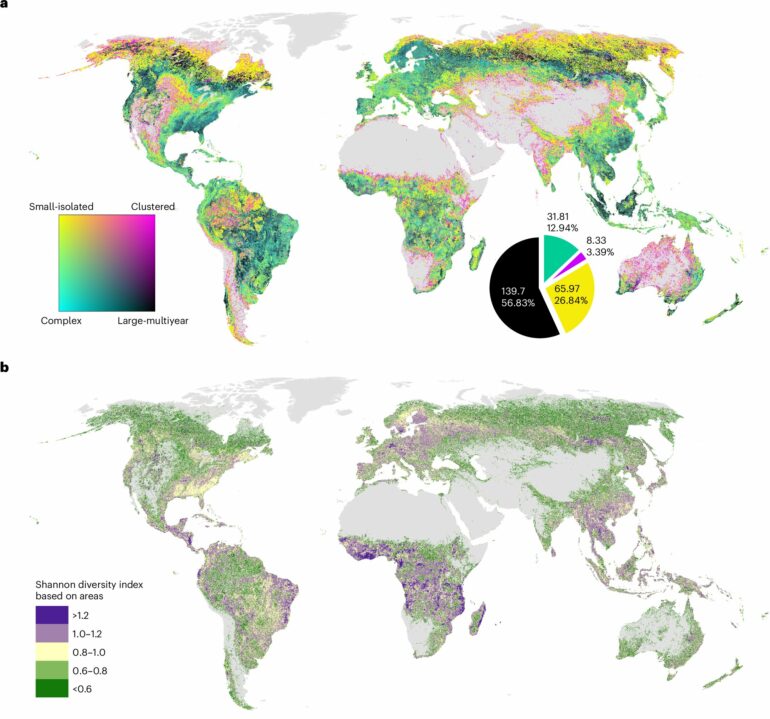Humans are leaving consistent patterns in forest disturbance structures across the world, according to a new study from the University of Leicester, the National Centre for Earth Observation (NCEO) and the University of Birmingham, based on remote sensing data.
Forests play a critical role in maintaining biodiversity, regulating the climate, and supporting ecosystems. However, disturbances such as storms, fires, insect outbreaks, and human activities like shifting agriculture and selective logging create significant impacts on forest structures. These events leave behind “disturbance patches,” areas where tree cover is lost, which vary in size, shape, and complexity. Understanding these patterns is key to managing forests sustainably and protecting their ecological functions.
Dr. Nezha Acil, an NCEO research scientist based at the University of Leicester, is the lead author in a study recently published in Nature Sustainability that analyzed global forest disturbance patterns from 2002 to 2014 using satellite data. The research, which was also part of her Ph.D. at the University of Birmingham, identified four main types of disturbance patches and mapped their distribution across different biomes.
Complex patches, characterized by medium sizes and long edges, were mostly found in forests that are subjected to human activities. Small-isolated and clustered patches dominated in remote and intact forests. Large and expanding patches were found mainly in association with fires in boreal and Mediterranean forests and with harvest in the Tropics.
Dr. Acil commented, “The structure of disturbance patches is helpful for identifying the causal agent of the disturbance. For example, tornadoes will tend to leave a long trail of damage, while clearcutting may leave regular and geometric shapes. Attributing disturbances to the causal agent is much needed for forest management and carbon accounting and is still unresolved at fine spatial resolution globally, particularly for those disturbances that are difficult to differentiate with remote sensing means.
“The landscape structure of stand-replacing disturbances has strong implications for forest recovery. It can influence the composition of the vegetation communities that will regrow which can alter succession trajectory and therefore forest regeneration.”
For example, smaller, irregular patches recover more quickly because they are closer to seed sources and less affected by altered microclimates. Larger or more uniform patches, however, may disrupt habitat connectivity, reduce biodiversity, and slow regrowth.
Disturbance patterns vary naturally across regions depending on environmental specificities and the agents of disturbances. A key insight reported by the research team is that human activities tend to leave similar patterns throughout the world independently of the biome. This has led to novel disturbance structures in the tropics, that contrast with the patterns naturally occurring there and to which the forests are adapted. This implies that a fundamental change is underway in these forests, with potential implications for their resilience.
Dr. Thomas Pugh, co-author and Ph.D. supervisor from the University of Birmingham, based at Lund University, commented, “The ongoing way in which people are altering the world’s forests really shines through in these results—different disturbance forms can in many cases be expected to lead to quite different forest structures in the future.”
The study warns that continued anthropogenic ‘homogenization’ of disturbance structures worldwide poses risks to forests’ natural diversity and complexity, which could have far-reaching consequences for carbon storage, biodiversity maintenance and ecological resilience.
By shedding light on the patterns of forest disturbances, the research provides a foundation for developing better nature-based forest management and conservation strategies. These insights are essential for mitigating climate change impacts and ensuring the sustainability of global forest ecosystems.
The research involved researchers from the University of Leicester, University of Birmingham, Technical University of Munich, Natural Resources Institute Finland (Luke) and Lund University.
More information:
Nezha Acil et al, Landscape patterns in stand-replacing disturbances across the world’s forests, Nature Sustainability (2024). DOI: 10.1038/s41893-024-01450-3
Provided by
University of Leicester
Citation:
Satellite data show human fingerprint on forest disturbance across regions (2024, December 5)



